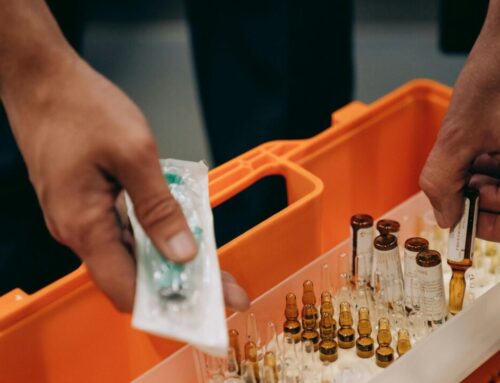Dry ice, also known as solid carbon dioxide (CO2), is a popular choice for a wide range of applications such as food preservation, transportation of medical supplies, and industrial cleaning. It is known for its ability to maintain a consistently low temperature, making it a reliable option for the above-mentioned applications. However, there are costs associated with using dry ice that may not be immediately apparent. So, what are the alternatives, and how do they match up to dry ice when it comes to effectiveness and cost?
Phase Change Materials (PCMs) are substances that absorb and release heat during the process of changing from one state to another, such as from solid to liquid or liquid to gas. They are commonly used in building materials, cold storage, and temperature-controlled packaging to regulate temperature and reduce energy consumption, making them a strong competitor to dry ice. Many substances can effectively act as a PCM; however, it requires extensive knowledge and research to develop a combination that allows them to maintain a constant exact temperature in the refrigerated or frozen range that is desired. The lifetime cost of using dry ice versus phase change material can vary depending on several factors.
Initial Cost
The first cost associated with using dry ice is the initial cost of purchasing it. The price of dry ice varies depending on the quantity and location, but on average, it can range from $1 to $3 per pound. Companies don’t purchase dry ice per package, but instead purchase huge volumes of dry ice that they then have to store until use. Huge attrition is unavoidable due to the instant sublimation process that begins as soon as the dry ice is formed and continues while it is sitting in storage, regardless of the temperatures.
Sublimation is a process by which a solid directly transforms into a gas, without first melting into a liquid. This unique property means that the dry ice simply “disappears” when it heats up. This can lead to a reduction in the amount of CO2 available for its intended use.An estimated five to ten pounds of dry ice will sublimate every 24 hours. Additionally, if dry ice is used as part of a business, it will be a recurrent cost that adds up every time it is needed.
The cost of purchasing phase change material varies depending on the type of material and the quantity required. Phase change materials can be expensive compared to traditional insulation materials, however, the cost can be offset by the energy savings achieved through the use of PCM plus the lifetime of PCM. Unlike dry ice, PCMs can be used and reused thousands of times without losing effectiveness.
Shipping Cost
If you need to transport dry ice to your location, you will need to factor in both shipping and sublimation costs. Dry ice needs to be shipped in special containers, with multiple specifications to keep it at the required temperature. These containers can be expensive to purchase or rent, and the shipping cost can be high due to the weight and hazardous nature of dry ice. This includes two dry ice blocks, 2 mil. plastic liner, an insulated container and an outer corrugated box.
During storage and transport of CO2 in solid form, some of it may undergo sublimation and escape into the environment as a gas. However, factors that can affect the extent of CO2 sublimation loss include temperature, pressure, and the nature of the container in which the CO2 is stored. Higher temperatures and lower pressures can accelerate the sublimation process, while poorly insulated or poorly sealed containers can lead to greater losses of CO2 gas.
On the other hand, PCMs don’t require any speciality shipping costs, outside of the costs associated with the weight and volume of the package which holds the contents and a PCM. The PCM in a hard shell, can be roughly 2.5 – 5 lbs, depending on the size of the PCM and the temperature that it will maintain. .
Storage Cost
Once you receive your dry ice, you will need to store it properly. Dry ice needs to be kept in a well-ventilated area that is not airtight, as it can release carbon dioxide gas as it sublimates. This means that you may need to purchase or rent specialized storage equipment, such as dry ice chests, to ensure that the dry ice remains in good condition.
There are little to no storage costs for PCM. PCM does not need to be stored frozen or refrigerated until right before use, which means PCM can be stored just about anywhere for any length of time, so there is no rush to use it.
Handling Cost
Dry ice is hazardous to handle, and it requires specialized training and equipment to handle it safely. If you do not have the necessary training and equipment, you may need to hire a professional to handle the dry ice for you. According to the International Air Transport Association (IATA) and the FAA, when shipping dry ice, it requires Dangerous Goods documentation and must be prepared by an employee trained in the Dangerous Goods regulations. This can add to the lifetime cost of using dry ice. CO2 sublimation may also pose safety risks, as the buildup of CO2 gas in enclosed spaces can lead to asphyxiation.
PCM is a safe, non-toxic, and environmentally friendly substance, packaged in containers similar to ice packs, making them easy to handle, and not requiring any additional special handling needs.
Disposal Cost
Dry ice is a hazardous material, and it cannot be disposed of in the same way as regular trash. It needs to be disposed of properly to ensure that it does not pose a risk to the environment or public health. Disposal costs can vary depending on the location and the amount of dry ice that needs to be disposed of.
The non-hazardous solutions of PCM were developed to cycle through the freeze/thaw phase change thousands of times without degradation of materials. PCM does not need to be disposed of as it has a much longer lifetime than dry ice which starts to evaporate as soon as it is created. This also means that the upfront investment in PCMs is spread throughout their lifetime, versus the continuous cost of replenishing more dry ice.
Environmental Cost
Dry ice is made from carbon dioxide, which is a greenhouse gas that contributes to climate change. The production and transportation of dry ice contribute to the carbon footprint of the industry. Using dry ice also produces carbon dioxide gas as it sublimates, which can contribute to local air pollution. In addition to the environmental effects of the gas itself, the ample packaging required to store and ship dry ice, creates a huge amount of waste for end users to dispose of when they receive their contents.
The environmental cost of using phase change material is generally lower than other insulation materials as it helps reduce energy consumption and greenhouse gas emissions. The material case that holds the PCM is made from food-grade high-density polyethylene (HDPE) plastic made of recycled materials, that are durable and keep contents from leaking. When combined with thermal packaging, it creates a measured environment cold enough to transport frozen food, vaccines, DNA, and more.
The lifetime cost of using dry ice goes beyond the initial cost of purchasing it. The cost of shipping, storing, handling, disposing, and the environmental impact should be taken into account. While dry ice can be a useful tool, it is important to weigh the costs and benefits carefully before making a decision. While the initial cost of PCMs may be higher than traditional insulation materials, the savings, safety and sustainability achieved through the use of PCMs can offset the initial cost. It is important to consider all the factors when deciding whether to use PCM or dry ice for your application.
Thermal Custom Packing provides an innovative alternative to dry ice, using PCMs and custom thermal totes. In addition to providing a cost-effect, green solution, we help companies achieve success with their cold chain transport through experience-based advisory services. Find out how you can avoid the lifetime costs of dry ice by connecting with us today.



